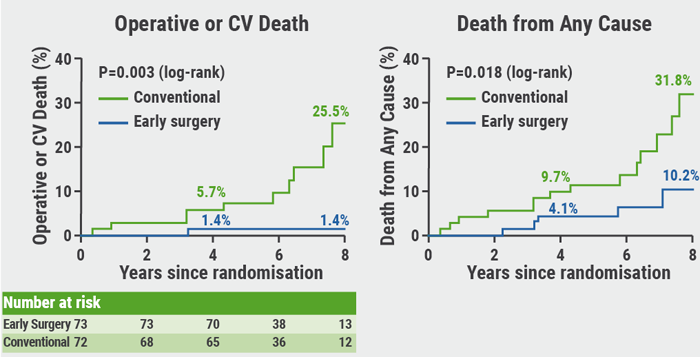Dr David Goldberg (Children’s Hospital of Philadelphia, USA) presented the 30-centre phase 3 clinical trial that attempted to address a problem resulting from the Fontan physiology, which can lead to deterioration of cardiovascular efficiency associated with a decline in exercise performance [1]. The researchers hypothesised that udenafil may improve exercise performance. The primacy efficacy endpoint of this study was a between-group difference in the change in oxygen consumption (VO2) from baseline to 26 weeks at peak exercise. Key secondary endpoints included myocardial performance index, exercise measures at ventilatory equivalents of CO2 at anaerobic threshold, brain natriuretic peptide, and reactive hyperaemia index.
Between 2017 and 2019, adolescents with Fontan physiology (n=400) were randomised to either udenafil 87.5 mg twice daily or placebo. The mean age was 15.5 ±2 years, and 60% of participants were male. All 400 participants were included in the primary analysis with imputation of the 26-week endpoint for 21 participants with missing data (i.e. 11 randomised to udenafil and 10 to placebo).
The primary efficacy endpoint was not met: peak oxygen consumption was not significantly changed, increasing by 44 ±245 mL/min (2.8%) in the udenafil arm and declining by 3.7 ±228 mL/min (-0.2%) in the placebo arm (P=0.071). However, improvements in the udenafil group versus the placebo group were evident in some of the secondary endpoints, including mean oxygen consumption (+33 ±185 [3.2%] vs -9 ±193 [-0.9%] mL/min, respectively; P=0.012), ventilatory equivalents of CO2 (-0.8 vs -0.06, respectively; P=0.014), and work rate (+3.8 vs +0.34 Watts, respectively; P=0.021). No differences were observed in the other secondary endpoints.
In conclusion, although the primary endpoint was not met, some benefits from udenafil treatment were observed in the secondary efficacy endpoints in patients with Fontan physiology, which may warrant further investigation.
1. Goldberg DJ et al. Longitudinal results from the Pediatric Heart Network: effect of udenafil on exercise performance after Fontan. LBS.05, AHA Scientific Sessions 2019, 14-18 November, Philadelphia, USA.
Posted on
Previous Article
« Apple Heart Study: Not just for atrial fibrillation Next Article
Full GALILEO results: Why did rivaroxaban fail after TAVR? »
« Apple Heart Study: Not just for atrial fibrillation Next Article
Full GALILEO results: Why did rivaroxaban fail after TAVR? »
Table of Contents: AHA 2019
Featured articles
New Approaches to CVD Risk Reduction
Phase 3 BETonMACE trial did not meet its primary endpoint
Inclisiran safely halves LDL-Cholesterol
Colchicine prevents cardiovascular events
Interventional Management for Acute Coronary Syndrome
Drop aspirin after 3 months in non-STEMI ACS patients on dual antiplatelet therapy
Immediate coronary angiography after cardiac arrest does not improve survival
Complete revascularisation for obstructive non-culprit lesions with vulnerable plaque
Colchicine: no difference in peri-procedural cardiovascular events 30 days post-PCI
Intra-aortic balloon pump better than Impella: new observational data
Results for the Ischemia Trials: To Intervene or Not to Intervene
ISCHEMIA trial: Invasive treatment only better for angina burden
Controversies in Contemporary Management of Aortic Stenosis
Full GALILEO results: Why did rivaroxaban fail after TAVR?
Balloon-expandable better than self-expanding transcatheter heart valves
RECOVERY: Benefit of early surgery in asymptomatic severe aortic stenosis
Guidelines: Updates and Controversies
New guidelines on the prevention of cardiovascular conditions
Trials in Electrophysiology and Left Ventricular Function
RENAL-AF trial: Apixaban similar to warfarin
Apple Heart Study: Not just for atrial fibrillation
Early apixaban safe as secondary prevention of stroke from AF
Carvedilol does not improve exercise performance in Fontan patients
New Frontiers in Lipid Therapy
Icosapent ethyl plus statins reduces total plaque volume
ORION-9: Inclisiran RNAi halves LDL in familial hypercholesterolaemia patients
New RNAi therapies to reduce triglycerides: 2 studies show favourable results
Targeting LDL-C <70 mg/dL is better than 100 mg/dL after stroke
Challenges in Heart Failure Management
FUEL trial: Udenafil improves some exercise measurements in Fontan
DAPA-HF: Dapagliflozin also good for heart failure patients without diabetes, of any age, or any health status
PARAGON-HF: Benefits for women and lower ejection fraction
Related Articles
February 26, 2020
Colchicine prevents cardiovascular events

February 26, 2020
Editor Biography

© 2024 Medicom Medical Publishers. All rights reserved. Terms and Conditions | Privacy Policy
HEAD OFFICE
Laarderhoogtweg 25
1101 EB Amsterdam
The Netherlands
T: +31 85 4012 560
E: publishers@medicom-publishers.com

